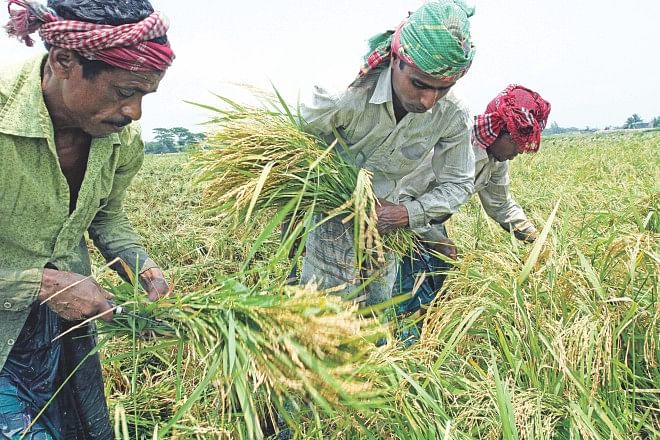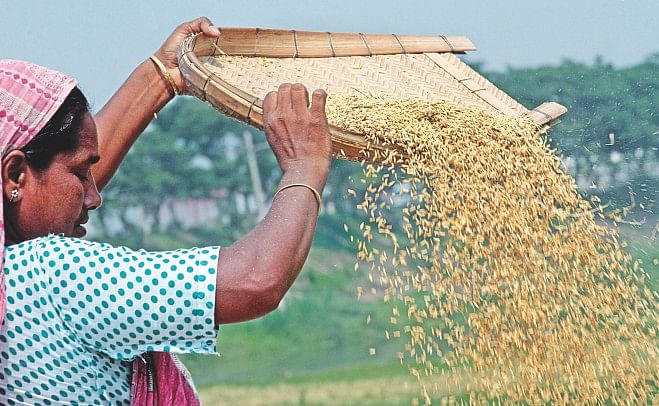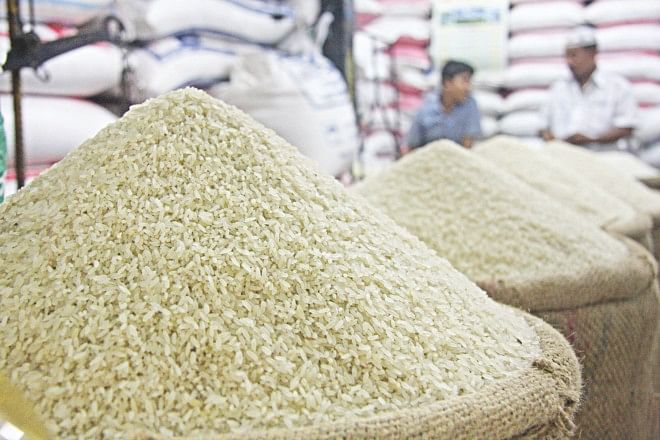Tale of a golden harvest

Amazing things are happening in the rice sector and yet we know so little of it. Have we ever paused and pondered from where nearly 16 crore people of the country are getting their supply of rice, at least two times a day? We know we do not import rice. We know the land area has not increased by a square meter in the last 42 years, but the population has more than doubled. And yet there has been no famine in the country or we have not heard of people dying of starvation. Something must have taken place behind our backs. What has happened, really?
To know this, we should go out at least once a year to the farmlands in a nearby village to see for ourselves how rice saplings are being cultivated and how the ripe sheaf of paddy are being harvested. We should also try to find some time to visit the institutions where agro scientists are doing painstaking research to develop high yield varieties of rice; rice saplings that would defy rising flood waters or drought or extreme cold. We should try to learn from the agro scientists how rice is being fortified with vitamins, minerals, iron etc., to supplement the nutrition need of the consumers.
Background
For centuries farmers have been cultivating rice in the alluvial soil of this Ganges–Brahmaputra delta in traditional methods and getting good yield per acre. In fact, cultivation of rice did not require much physical effort or support of farm machinery in the past because of abundantly available water, nutrient-rich soil and favourable
weather. But from the middle of the 20th century farmlands started to give lesser yields and the quality of rice also began to deteriorate for various environmental and man-made factors. Industrialisation and resulting pollution slowly began to creep in to the agro lands to expedite the damage.
Towards the end of the last century, the country found itself faced with a double predicament. While on the one hand yield per acre began to fall, on the other, country's population started to grow at an alarming pace. Soon the question came up as to how such a huge population will be fed when our land remains limited and farmlands getting lost to other sectors. Situation in the areas where only one rice variety can be cultivated in a year became more severe needing immediate attention to avert famine or famine like situation.
The emerging situation necessitated agriculture scientists to delve in vigorous research with rice in a bid to face the challenges. Highly qualified agro scientists, trained locally and internationally, devoted their time and talent to find ways to solve the problems with rice. As research activity intensified it began to give desired results. We saw per acre yield of rice doubling within a decade
The turnabout
Bangladesh produced about 11 million tons of rice in 1971 when the country's population was only about 7.5 crore. By the mid '80s, Bangladesh became the fourth largest rice producer in the world. It is currently the world's sixth-largest producer.
The country now produces about 25 million tons to feed its present population of 16 crore. The increased rice production has been possible largely due to the practical and timely interventions by the Ministry of Agriculture and relentless research by the agro-scientists of the country. This included timely supply of developed seeds, fertilisers, insecticides and irrigation pumps. Here the positive role of International Rice Research Institute (IRRI), Bangladesh Agriculture Research Centre (BARC) and Bangladesh Rice Research Institute (BRRI) also needs to be mentioned.
The challenges
There is no room for complacency. Because the present reality is the population of Bangladesh is growing by two million every year which may increase by another 30 million over the next 20 years. Thus, Bangladesh will require over 27.26 million tons of rice in the year 2020. During this time total rice area will also shrink to 10.28 million hectares. To feed the growing millions, rice yield needs to be increased from the present 2.74 to 3.74 t/ha. (Source: Bangladesh Rice Research Institute - BRRI). Therefore, the importance of taking all necessary steps for the survival, protection and development of different varieties of rice in Bangladesh needs no emphasizing.
Will Bangladesh be able to achieve these targets within the stipulated time?
The answers are available with the Ministry of Agriculture and BRRI, as they are going ahead with research on finding high-yielding varieties of rice and also developing seeds that would withstand vagaries of nature in different seasons. They are optimistic about finding ways to increase production of rice per acre of land and control damages caused by floods, droughts, cold and salinity.

Research works by BRRI:
Among the research institutes the name of Bangladesh Rice Research Institute (BRRI) comes to the fore because of some praiseworthy research works done by its scientists in the last twenty years. What they have done so far needs to be highlighted and recognized by the relevant authorities. This writer had the opportunity to talk to the present Director General and senior scientist of BRRI DR. Jiban Krishna Biswas recently on the state of research on various types of rice and what benefit consumers will get from them. The following prelude to the situation of rice quality, rice production and nutritional aspects was extracted from a technical paper prepared by Dr. Biswas some months ago: “Malnutrition due to deficiency of different micronutrients is a serious public health problem in most of the developing countries. About 40 percent of the world's population suffers from micronutrient deficiencies such as iron, zinc and vitamin A (WHO, 1999). Globally around 5 million children under the age of five die every year as a direct consequence of micronutrient malnutrition (MNM). UNICEF's 2013 report shows that globally in 2011, an estimated 165 million children under age of 5 are afflicted by stunting in the world due to micronutrient malnutrition.
“It is a growing concern among the poor people in South and Southeast Asia where rice is widely produced and consumed. Rice is consumed more than half a kilogram in some countries in this region. Rice is more or less the only food for many people in these countries and most of the energy intake comes from rice. Rice is a popular filling food but it is deficient in many essential micronutrients like iron, zinc, vitamin E and vitamin A (Vasconcelos et al., 2003; Tan et al., 2005), thus reliance on rice as a primary food does not address micronutrient malnutrition.
“However, access to food and nutrition is a basic human right and it ensures healthier and productive life. A better nutritional standard can be attained only if the diet is balanced with respect to calories, vitamins, minerals and proteins. A large proportion of the population in developing countries like Bangladesh cannot afford a balanced diet to cover their daily micronutrient requirements. People need regular access to vegetables, fruits and animal sources to meet their daily micronutrient needs, but these are seasonal and perishable goods, and often unaffordable or culturally unacceptable.
“Here are the major deficiencies that afflict our population, especially children:
Vitamin A deficiency (VAD)
VAD is one of the major outcomes of malnutrition causing temporary to permanent eye impairments and increased mortality due to infections, especially among children, pregnant and lactating mother. Night blindness is one of the first signs of VAD. It also contributes to maternal mortality and other poor outcomes in pregnancy and lactation (WHO, 2008; Latham, 1997; Sommer, 1995 and UNICEF, 2002). VAD is becoming a major health problem in the developing countries affecting millions of children and pregnant women. Recent studies show that not less than 20 per cent of children of 6-59 months old and one in every 10 pregnant women and lactating mothers in Bangladesh are deficient in vitamin A (ICDDRB 2013). Many people in the developing world do not get enough vitamin A or beta carotene from the food they eat, contributing to the serious public health problem of vitamin A deficiency.
Golden Rice: A potential new approach for combating VAD
Dr. Biswas says that 'Golden Rice' is a “genetically engineered new type of rice which contains beta carotene giving its grain a unique golden color. Beta-carotene is converted in the body as vitamin A. Based on studies published in the American Journal of Clinical Sciences (Tang et al. 2009), eating one cup of Golden Rice would be able to supply half (50%) of the needed vitamin A of one adult in one day. Another study in China with young children (Tang et al. 2012) showed that golden rice beta-carotene is as good as beta-carotene in oil what is provided among the children under the age of five in the national vitamin A supplementation program. Because rice is widely grown and consumed all over Bangladesh, Golden Rice is expected to reach many consumers, including those who do not have reliable access to or cannot afford other sources of vitamin A. To help the adaptation of Golden Rice, BRRI has introduced the Golden Rice trait into popular rice varieties keeping similar agronomic performance and resistance to major diseases and insect pests.
Zinc and Iron deficiency
According BRRI sources: “Zinc and Iron are two essential micronutrients for human health. They are directly involved in many biological functions in human body. More than 200 enzymatic systems related to normal growth and cognitive development, and immunity are dependent on these two minerals. Recent report shows that poor nutrition in the first 1,000 days of children's lives can have irreversible consequences like stunting (UNICEF 2013). Stunting and other forms of malnutrition reduce a child's chance of survival, while also hindering optimal health and growth. Stunting is associated with suboptimal brain development, which is likely to have long-lasting harmful consequences for cognitive ability, school performance and future earnings. This in turn affects the development potential of nations. The 2013 UNICEF's report shows that in 2011, 41% of preschool age children of Bangladesh were stunted of which 54% belonged to the poorest community. This report also shows that prevalence of anaemia among preschoolers was as high as 51%.

What has BRRI done to address this problem?
To address this deficiency, BRRI scientists released a zinc enriched rice variety for rain fed low ecosystem. This variety contains 19.6 mg zinc per kilogram of polished rice. Protein percentage of this variety is 9%. BRRI Dhan62 has potential to yield 4.5 t/ha on average with growth duration of only 100 days, thus it would be suitable to the area where farmers want to grow early potato or winter vegetables to earn some cash money with no delay in planting of Boro crop. The scientists are working on another high zinc breeding line which will be released for irrigated ecosystem, the most productive rice growing ecosystem in Bangladesh.
Low GI Rice: Boon for the diabetic
On the question of addressing the problem of diabetes, BRRI sources say: “The glycemic index is a useful aid for diabetes management and for people who wish to control their blood glucose levels. Diets based on foods with low glycemic response have been found associated with low level of blood glucose, improved blood lipids (cholesterol), reduced risk of heart disease, and weight management. Food value in rice is very simple and it releases energy very fast compared to other cereals after ingestion. Bangladesh Rice Research Institute is working on screening rice germplasms to find out potential donors for this trait. A BRRI developed rice variety, BR16 has already been identified as a low GI variety. In fact, it was not bred targeting this trait. Some private companies in the country are now marketing this rice as 'Diabetic rice'.”
Some worthwhile research works:
Stress tolerant rice varieties developed by BRRI
Drought tolerance:
Upland (Broad cast Aus): BR20, BR21, BR24, BRRI dhan42, BRRI dhan43
Transplanted Aman: BRRI dhan56 and BRRI dhan57
Submergence tolerance: BRRI dhan51 and BRRI dhan52
Salinity tolerance:
Transplanted Aman: BRRI dhan40, BRRI dhan41, BRRI dhan53 and BRRI dhan54, Boro: BRRI dhan47 and BRRI dhan61, BRRI dhan55 (to some extent)
Cold temperature tolerance: BRRI dhan36, BRRI dhan55
BPH (Brown Plant Hopper) tolerant
What are the plans of BRRI for the future?
- Replacement of local varieties by modern varieties in T. aman season where possible.
- Limited increase in modern variety boro area.
- Replacement of the present varieties by superior inbred, hybrid and super high yielding varieties.
- Increment of irrigation areas in both boro and T. aman season.
- Application of superior resource management technologies.
- The use of quality seeds.
- Mechanization of rice cultivation particularly minimization of post-harvest losses.
Director General of BRRI says that although rice is widely grown and consumed in Bangladesh, nutritional campaign with micronutrient enriched rice might face some major hurdles. Quality control in screening of rice germplams for micronutrients is one of the prime concerns. Inadequate infrastructure and laboratory facilities and lack of trained manpower are the limiting factors in the path of progress.
Some private research findings:
A paper titled “Rice Economy of Bangladesh Progress and Prospects” authored by Raisuddin Ahmed says the following:
“The growth in the production of rice that has occurred during the past two decades was realised through improvement in yield.
Intensification of the use of modern inputs played a key role in increased production. The land resources allocated to rice actually declined over time, particularly during the 1990s and early 2000s. Between 1975-77 and 1999–2001, production doubled, yield has more than doubled, but land area under rice has declined from 25 million acres to 22.8 million acres.
Agricultural technology: Irrigation-based seed-fertiliser technology constituted the foundation for growth in rice production in Bangladesh. HYV seeds, irrigation, and fertilisers were the three critical elements of the technology package. All technological indicators demonstrate a robust progress in the diffusion of modern technology. Irrigation is now provided to half of the land under rice and two-thirds of the rice area is planted with modern varieties. Fertiliser application has reached an average level of 114 kg per acre against only 19.4 kg in the late 1970s. According to the 1996 Census, 82.6 per cent of all farmers use fertiliser and 71 per cent of the gross cropped area is fertilised.”
The writer is Special Supplements Editor, The Daily Star.

 For all latest news, follow The Daily Star's Google News channel.
For all latest news, follow The Daily Star's Google News channel. 



Comments